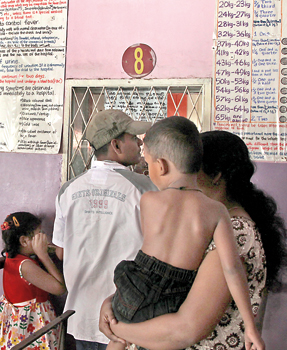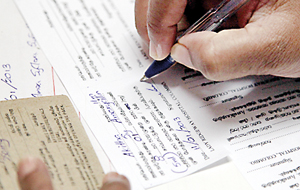‘It’s time for your medicine!’
View(s):Director of Lady Ridgeway Hospital for Children Dr. Rathnasiri A. Hewage, discusses the role carers, doctors and pharmacists should play when treating children
Medicine should be given to children only when it is necessary, and in all cases the potential benefit of administering the medicine should be considered in relation to the risk involved.
Discuss treatment options with your Doctor
It is important to discuss treatment options carefully with the child and their doctor. The doctor should help the child, and the child’s carer, to distinguish between the adverse effects of prescribed drugs from the effects of the medical disorder. When the beneficial effects of the medicine are likely to take time, this should be highlighted by the doctor.
Taking medicines to best effect
Difficulties in adherence to drug treatment occur regardless of age. Factors that contribute to poor compliance with prescribed medicines include:
- difficulty in taking the medicine (e.g. inability to swallow the medicine)
- unattractive formulation (e.g. unpleasant taste)
- prescription not collected or not dispensed
- purpose of medicine not clear
- perceived lack of efficacy
- real or perceived side-effects
- carers’ or child’s perception of the risk and severity of side-effects may differ from that of the prescriber
- ambiguous instructions for administration
The prescriber, the child’s carer, and the child (if appropriate) should agree on the health outcomes desired and on the strategy for achieving them (‘concordance’). It is important that the doctor is informed about the religious, cultural, and personal beliefs of the child’s family.
The role of the pharmacist
It is a duty of the doctor to take the time to explain to the child (and carers) the rationale and the potential adverse effects of treatment as this may improve compliance. Reinforcement and elaboration of the physician’s instructions by the pharmacist of adverse effects and the possibility of alternative treatments may encourage carers and children to seek advice rather than merely abandon unacceptable treatment. Therefore, it is very important to get medications from a well qualified pharmacist.
Administration of medicines to children
Children should be involved in decisions about taking medicines and encouraged to take responsibility for using them correctly. The degree of such involvement will depend on the child’s age, understanding, and personal circumstance.

Waiting to collect medicines from the pharmacist's counter at the LRH. Pix by M.A. Pushpa Kumara
Occasionally a medicine or its taste has to be disguised or masked with small quantities of food. However, unless specifically permitted, a medicine should not be mixed or administered in a baby’s feeding bottle.
Liquid formulations
Children under five years (and some older children) find a liquid formulation more acceptable than tablets or capsules. However, for long-term treatment if may be possible for a child to be taught to take tablets or capsules.
An oral syringe should be used for accurate measurement and controlled administration of an oral liquid medicine. The unpleasant taste of an oral liquid can be disguised by flavouring it or by giving a favourite food or drink immediately afterwards, however the potential for food-drug interactions should be discussed beforehand with the doctor or the pharmacist.
It is important to check and take care of the dental hygiene of those receiving medicines containing cariogenic sugars.
Managing medicines in school
Administration of a medicine during school time is generally avoided if possible. Medicines are prescribed for once or twice-daily administration whenever practicable. But, if the medicine needs to be taken in school, this should be discussed with teachers and the necessary arrangements made in advance; where appropriate, involvement of a school nurse should be sought.
Supply of medicines
When supplying a medicine for a child, a pharmacist should ensure that the child and the child’s carer understand the nature and identity of the medicine and how it should be used. The child and the carer should be provided with appropriate information (e.g. how long the medicine should be taken for and what to do if a dose is missed or the child vomits soon after the dose is given).
Safety in the home
Carers and relatives of children must take care to keep all medicine out of the reach and sight of children. Tablets, capsules and oral and external liquid preparations should ideally be dispensed in a re-sealable child-resistant container
In developed countries all patients are advised to return all unwanted medicines to a pharmacy for disposal.
Validity of prescriptions
Pharmacists should not issue drugs without prescriptions. Where there is any doubt about the authenticity of a prescription, the pharmacist should contact the prescriber.
If a pharmacist receives an incomplete prescription the following procedures will apply;
- an attempt must always be made to contact the prescriber to ascertain the intention
- if the attempt is successful the pharmacist must, where practicable, subsequently arrange for details of quantity, strength where applicable, and dosage to be inserted by the prescriber on the incomplete form
- if the pharmacist has any doubt about exercising discretion, an incomplete prescription must be referred back to the prescriber.
Labelling medicines
The name of the medicine should appear on the label unless the prescriber indicates otherwise. The strength should also be stated on the label as many preparations are available in different strengths.

Medicines being labelled
Labels should indicate the total quantity of the product dispensed in the container to which the label refers. This requirement applies equally to solid, liquid, internal and external preparations. If a product is dispensed in more than one container the reference should be to the amount in each container.
Drug treatment in children
Children, and particularly neonates, differ from adults in their responses to drugs, Special care is needed in the neonatal period (first 28 days of life) and doses should always be checked with care.
Dose frequency
Most drugs can be administered at slightly irregular intervals during the day. Some drugs, e.g. antimicrobials, are best given at regular intervals. Some flexibility is allowed in children to avoid waking them during the night, for example, the night-time dose may be given at the child’s bedtime.
Follow @timesonlinelk
comments powered by Disqus
















